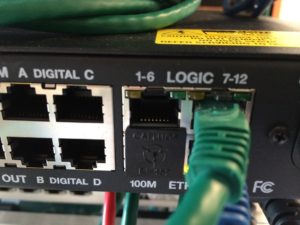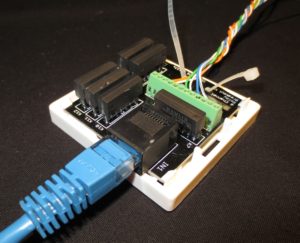The NotaBotYet 6-Channel GPIO Relay Board can be used in conjunction with Wheatnet-IP Logic I/O ports to control tally lights on popular mic arms. Most of these types of mic arms have a ring of multiple LEDS that are used to indicate which mic is live on the air. These LEDs at 12 volts typically draw 30-40 milliamps of current, and possibly more at 24 volts. This is more current than a logic I/O port on a Wheatnet-IP device is rated to handle. Many engineers out there have resorted to creating some type of perf-board circuit with transistors or relays to control these tally lights. Some have even gone with quick and dirty “transistor directly in the euroblock” method of wiring.
The problem is that none of these methods are easy or quick to install. With the 6-Channel GPIO Relay Board, NotaBotYet has already done the heavy lifting for you to make your installation fast and easy. Typically, when using this board, the most time will be spent stripping wires on the mic arm to find the correct colors rather than making connections to the logic I/O port itself. The diagram above demonstrates how it all goes together. All that is required to make the proper connections are: the mic arm with tally light built in, a Logic I/O port on any given Wheatnet-IP device, a 12v to 24v power supply to power the tally light itself, some wire, a Cat-5 Patch cable, and the NotaBotYet 6-Channel GPIO Relay Board. The normally open relay contacts will activate upon the Logic I/O port bit closing to ground, thereby completing the circuit to the tally light, and remaining completely electrically isolated from the other relays on the baord as well as the GPIO port itself. Voltage to control the relays is supplied by the Logic I/O port itself.
The diagram above demonstrates how it all goes together. All that is required to make the proper connections are: the mic arm with tally light built in, a Logic I/O port on any given Wheatnet-IP device, a 12v to 24v power supply to power the tally light itself, some wire, a Cat-5 Patch cable, and the NotaBotYet 6-Channel GPIO Relay Board. The normally open relay contacts will activate upon the Logic I/O port bit closing to ground, thereby completing the circuit to the tally light, and remaining completely electrically isolated from the other relays on the baord as well as the GPIO port itself. Voltage to control the relays is supplied by the Logic I/O port itself.
The board easily connects to the logic port of the blade with a simple cat 5 cable. The input pinouts of the 6 Channel GPIO Relay Board’s RH-45 connector already match those of the Logic I/O port of the Wheatnet-IP Blade. This allows the use of any pre-manufactured straight-thru cat-5 patch cable to be used for this purpose. The 6-Channel Relay Board can be surface mounted nearly anywhere in studio furniture or equipment racks using either double-sided adhesive or screws.

Connection to Logic I/O Port Using Cat-5 Patch Cable Made in Rear of Wheatnet-IP Blade.
The normally open relay contacts will activate upon the GPIO port bit closing to ground, thereby completing the circuit to the tally light, and remaining completely electrically isolated from the other relays on the board as well as the GPIO port itself.
Output connections are made on a standard “phoenix” type terminal block.
Use of this board does require that all the logic bits on the particular port are set to “output” mode. However one device can control up to 6 tally lights simultaneously which should be enough for most studios.

